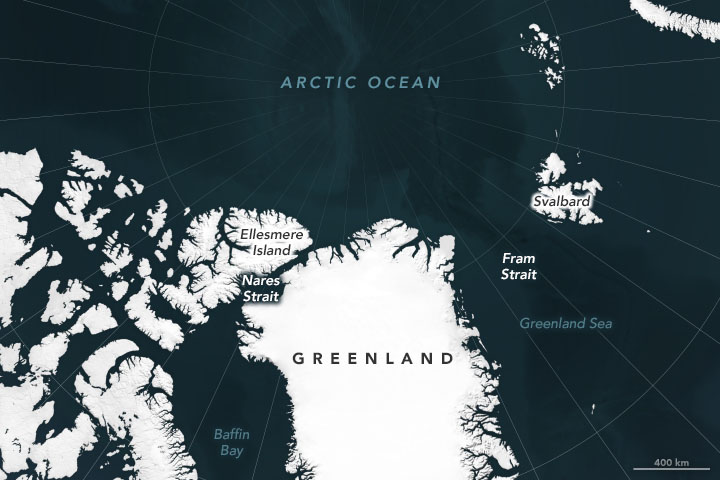

A structure in the Nares Strait known as an “ice arch” was still intact in late May 2020 when the Moderate Resolution Imaging Spectroradiometer (MODIS) on NASA’s Terra satellite acquired this natural-color image. But check it out while you still can. This natural gatekeeper—which prevents sea ice from exiting the Arctic Ocean and drifting southward into Baffin Bay—typically breaks up each year by June or July.
The Arctic Ocean is considered a semi-enclosed ocean, as it is surrounded almost entirely by land. The northern coastlines of these land masses—Eurasia, North America, Greenland—and some scattered islands keep most of the sea ice penned up, making it less mobile than sea ice that forms around Antarctica.
There are a few passageways, however, that allow ice to escape in spring and summer. The main passage is through the Fram Strait between northeast Greenland and Svalbard. Another is through the Nares Strait between northwest Greenland and Ellesmere Island. Nares Strait is relatively narrow, but a southward flowing current ensures plenty of Arctic sea ice is lost there each year.
How much ice is lost via the Nares Strait depends in part on how soon the ice arch breaks up each year. In 2019 the ice arch collapsed early, crumbling in mid-April and allowing ice to flow freely by May. Early breakups also occurred in 2017, 2010, and 2008. In 2007, the arch failed to form at all.
The ice arch in 2020 has proved to be more stable. Satellite images show the arch intact on May 22 (above) and it remained so as of the publishing of this story.

According to Walt Meier, a sea ice researcher at the National Snow and Ice Data Center, the timing of the breakup depends on factors including ice thickness, air temperature, and wind direction. Thick ice is more stable and tends to break-up later than thin ice. In the strait, thick ice can build up during winters with cold air temperatures; it can also accumulate from thick, multi-year ice that drifts in from the north and gets “wedged” in the strait.
By spring, warmer temperatures begin to melt the ice, causing it to thin and weaken. Temperatures in spring 2020 have been warmer than normal over the Nares Strait, although not as extreme as other parts of the Arctic including Siberia.
But you need more than thin ice and warm temperatures to destroy the ice arch. “Warmer temperatures in the spring don’t necessarily indicate an early break-up,” Meier said. “The ice needs to be weak enough to break up, but then the winds blowing in the right direction give it a ‘final kick’ for the arch to collapse.”
The “right direction” refers to winds blowing parallel to the strait, forcing ice southward. Meier noted that over the past few months, a low-pressure circulation pattern in the central Arctic has resulted in winds blowing perpendicular to Nares Strait. “These are not winds that would tend to initiate the break-up,” he said.
Meier speculated that this same wind pattern could be responsible for churning up the sea ice and causing tough conditions for the Polarstern—an icebreaker currently drifting in Arctic sea ice for the MOSAiC science expedition. “So, that large-scale circulation may have contributed to both ridging and thicker ice along Polarstern's route,” Meier said, “as well as winds that are favorable to preserving the arch.”
NASA Earth Observatory images by Lauren Dauphin and Joshua Stevens, using MODIS data from NASA EOSDIS/LANCE and GIBS/Worldview. Story by Kathryn Hansen.